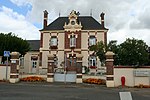Fondation Monet in Giverny

The Fondation Claude Monet is a nonprofit organisation that runs and preserves the house and gardens of Claude Monet in Giverny, France, where Monet lived and painted for 43 years. Monet was inspired by his gardens, and spent years transforming them, planting thousands of flowers. He believed that it was important to surround himself with nature and paint outdoors. He created many paintings of his house and gardens, especially of water lilies in the pond, the Japanese bridge, and a weeping willow tree. With a total of 530,000 visitors in 2010, it is the second most visited tourist site in Normandy after the island of Mont Saint-Michel. The house and gardens have been recognised as among the Maisons des Illustres, and a Jardin Remarquable, rewarding their outstanding qualities. The estate was classified as a monument historique in 1976. Monet's paintings of the gardens, especially the sites' pond with water lilies, are exhibited in dozens of major collections.
Excerpt from the Wikipedia article Fondation Monet in Giverny (License: CC BY-SA 3.0, Authors, Images).Fondation Monet in Giverny
Rue Claude Monet, Les Andelys
Geographical coordinates (GPS) Address Nearby Places Show on map
Geographical coordinates (GPS)
| Latitude | Longitude |
|---|---|
| N 49.075 ° | E 1.5356 ° |
Address
Rue Claude Monet 90
27620 Les Andelys
Normandy, France
Open on Google Maps






